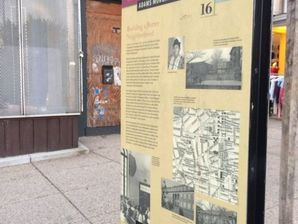Building a Better Neighborhood
Front
Across the street you can see the Marie H. Reed Community Learning Center. It opened in 1977 on the former sites of Morgan Community School and Happy Hollow Playground.
Both the Adams and Morgan elementary schools became "community schools" in the 1960s. Their curricula and policies were controlled by locally elected residents with the cooperation of the D.C. School Board. The schools also provided important social services. The new Reed Center followed suit with a public health clinic, child care center, adult education, and swimming pool. Its name honors Bishop Marie H. Reed (1915-1969), founder of Sacred Heart Spiritual Center and leader of the community school movement.
The original Morgan School was named after City Commissioner Thomas P. Morgan, whose Oak Lawn estate was on the site of today's Washington Hilton. At first Morgan School served white children. Then in 1929, when the John Quincy Adams School was built for them on 19th Street (Adams once owned land along Rock Creek), African American students were given the old Morgan School. By the 1950s, Washington's black schools were overcrowded and run down, while white schools were under-enrolled due to "white flight" to the suburbs.
When the Supreme Court ruled that school segregation was unconstitutional in 1954, Washington's schools were ordered to desegregate immediately as a model for the nation. Here, black and white community members had already laid the groundwork for better schools and improved race relations. In 1955 school officials and residents created the Adams Morgan Better Neighborhood Conference—and the Adams Morgan name stuck.
Back
The Adams Morgan story begins with its breezy hilltop location, prized by Native Americans, colonial settlers, freedom seekers, powerful Washingtonians, working people, and immigrants alike. Unlike most close-in neighborhoods, Adams Morgan has never been dominated by any of these groups. Today's rich diversity is the legacy of each group that has passed through.
Follow the 18 signs of Roads to Diversity: Adams Morgan Heritage Trail to discover the personalities and faces that shaped a community once known simply as "18th and Columbia." Along the way, you'll learn how school desegregation led to the name Adams Morgan, and you'll meet presidents and paupers, natives and immigrants, artists, activists and authors.
Roads to Diversity: Adams Morgan Heritage Trail, a booklet capturing the trail's highlights is available at local businesses. To learn about other DC neighborhoods, check out City Within a City: Greater U Street Heritage Trail, beginning at 16th and U streets, and visit: www.CulturalTourismDC.org



